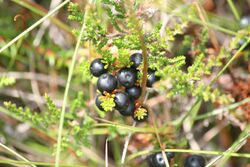Biology:Empetrum nigrum
| Black crowberry | |
|---|---|

| |
| Scientific classification | |
| Kingdom: | Plantae |
| Clade: | Tracheophytes |
| Clade: | Angiosperms |
| Clade: | Eudicots |
| Clade: | Asterids |
| Order: | Ericales |
| Family: | Ericaceae |
| Genus: | Empetrum |
| Species: | E. nigrum
|
| Binomial name | |
| Empetrum nigrum | |
| Synonyms[2] | |
| |
Empetrum nigrum, crowberry,[3] black crowberry, or, in western Alaska, blackberry, is a flowering plant species in the heather family Ericaceae with a near circumboreal distribution in the Northern Hemisphere. It is usually dioecious, but there is a bisexual[4] tetraploid subspecies, Empetrum nigrum subsp. hermaphroditum, which occurs in more northerly locations and at higher altitude.[5][6]
Description
Empetrum nigrum is a low growing, evergreen shrub with a creeping habit.[7] The leaves are 3–6 millimetres (1⁄8–1⁄4 inch) long, arranged alternately along the stem. The stems are red when young and then fade to brown. It blooms between May and June.[8] The flowers are small and not very noticeable,[7] with greenish-pink sepals that turn reddish purple.[9] The round fruits are drupes, 4–6 mm (1⁄8–1⁄4 in) wide, usually black or purplish-black but occasionally red.[10]
The metabolism and photosynthetic parameters of Empetrum can be altered in winter-warming experiments.[11]
Subspecies
- Empetrum nigrum subsp. asiaticum (Nakai ex H.Ito) Kuvaev – Korean crowberry[12]
- Empetrum nigrum subsp. subholarcticum (V.N.Vassil.) Kuvaev (synonym: Empetrum subholarcticum V.N.Vassil.)[13]
Distribution and habitat
The species has a near circumboreal distribution in the Northern Hemisphere.[citation needed] It is also native in the Falkland Islands.[14][15]
Evolutionary biologists have explained the striking geographic distribution of crowberries as a result of long-distance migratory birds dispersing seeds from one pole to the other.[16]
Empetrum nigrum grows in acidic soils in shady, moist areas.
Ecology
The moth species Glacies coracina, Zygaena exulans, and Hadula melanopa feed on the plant.[8]
Uses
The fruit is edible and can be dried.[17] However, it has an acidic taste and can cause headaches.[8] It is abundant in Scandinavia and treasured for its ability to make liqueur, wine, juice, or jelly. In subarctic areas, the plant has been a vital addition to the diet of the Inuit and the Sami. The Dena'ina (Tanaina) harvest it for food, sometimes storing in quantity for winter, sometimes mixed with lard or oil.
The species can also be grown as a ground cover,[18] or as an ornamental plant in rock gardens, notably the yellow-foliaged cultivar 'Lucia'. The fruit is high in anthocyanin pigment and can be used to make a natural dye.[18]
Culture
The Scottish Highlands Clan Maclean's badge is believed to be E. nigrum; cuttings of it would be raised on standards to denote clan identity and allegiance.
References
| Wikimedia Commons has media related to Empetrum nigrum. |
- ↑ Sp. Pl. 2: 1022. 1753 [1 May 1753] "Plant Name Details for Empetrum nigrum". IPNI. http://www.ipni.org:80/ipni/idPlantNameSearch.do;jsessionid=F2CFBFD7E35FC281DC585FFC6C2465B8?id=324780-1.
- ↑ "Empetrum nigrum L.". Board of Trustees of the Royal Botanic Gardens, Kew. 2017. https://powo.science.kew.org/taxon/urn:lsid:ipni.org:names:30371508-2.
- ↑ Chisholm, Hugh, ed (1911). "Crowberry". Encyclopædia Britannica. 7 (11th ed.). Cambridge University Press. p. 513.
- ↑ Jepson Flora Project, ed., "Empetrum nigrum", Jepson eFlora, The Jepson Herbarium, University of California, Berkeley, http://ucjeps.berkeley.edu/eflora/eflora_display.php?tid=24229
- ↑ Stace, C. A. (2010) New Flora of the British Isles, 3rd edition. Cambridge University press. ISBN:978-0-521-70772-5. pp. 525.
- ↑ Kråkbär (in Swedish)
- ↑ 7.0 7.1 Barbara Coffin; Lee Pfannmuller (1988). Minnesota's Endangered Flora and Fauna. U of Minnesota Press. p. 96. ISBN 978-0-8166-1689-3. https://books.google.com/books?id=wfWNq91AjeoC.
- ↑ 8.0 8.1 8.2 Reader's Digest Field Guide to the Wild Flowers of Britain. Reader's Digest. 1981. p. 220. ISBN 978-0-276-00217-5.
- ↑ "Empetrum nigrum in Flora of North America @ efloras.org". http://www.efloras.org/florataxon.aspx?flora_id=1&taxon_id=200012671.
- ↑ "Jepson eFlora: Empetrum nigrum". University and Jepson Herbaria. University of California, Berkeley. http://ucjeps.berkeley.edu/cgi-bin/get_IJM.pl?tid=24229.
- ↑ Bokhorst, S; Bjerke, JW; Davey, MP; Taulavuori, K; Taulavuori, E; Laine, K; Callaghan, TV; Phoenix, GK (2010). "Impacts of extreme winter warming events on plant physiology in a sub-Arctic heath community". Physiologia Plantarum 140 (2): 128–140. doi:10.1111/j.1399-3054.2010.01386.x. PMID 20497369.
- ↑ English Names for Korean Native Plants. Pocheon: Korea National Arboretum. 2015. pp. 456. ISBN 978-89-97450-98-5. http://www.forest.go.kr/kna/special/download/English_Names_for_Korean_Native_Plants.pdf. Retrieved 24 December 2016.
- ↑ "Empetrum subholarcticum V.N.Vassil.". http://www.worldfloraonline.org/taxon/wfo-0000667274.
- ↑ {{citation | mode = cs1 | title = Empetrum nigrum | work = Germplasm Resources Information Network (GRIN) | url = | publisher = [[Organization:Agricultural Research ServAgricultural Research Service (ARS), United States Department of Agriculture (USDA) | access-date = 15 December 2017 }}
- ↑ "Empetrum nigrum L.". PLANTS. http://plants.usda.gov/java/profile?symbol=EMNI.
- ↑ Magnus Popp; Virginia Mirré; Christian Brochmann (2011). Peter H. Raven. ed. "A single Mid-Pleistocene long-distance dispersal by a bird can explain the extreme bipolar disjunction in crowberries". PNAS (Missouri Botanical Garden, St. Louis, Missouri) 108 (16): 6520–6525. doi:10.1073/pnas.1012249108. PMID 21402939.
- ↑ United States Department of the Army (2009) (in en-US). The Complete Guide to Edible Wild Plants. New York: Skyhorse Publishing. pp. 47. ISBN 978-1-60239-692-0. OCLC 277203364. https://www.worldcat.org/oclc/277203364.
- ↑ 18.0 18.1 "Empetrum nigrum - L.". Plants for a Future. http://www.pfaf.org/user/plant.aspx?latinname=Empetrum+nigrum.
Wikidata ☰ Q202305 entry
 |




